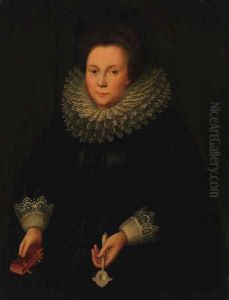Jacob Willemsz. Delff Paintings
Jacob Willemsz. Delff was a Dutch painter of the Northern Renaissance, born in 1550 in the city of Gouda, Netherlands. He was part of a family of artists, with both his father, Willem Jacobsz Delff, and his son, Willem Jacobsz Delff the younger, also being painters. His family's artistic legacy continued through his other son, Cornelis Jacobsz Delff, who became a still-life painter, and his daughter Maria married the painter Willem van Aelst.
Jacob Delff's career flourished in the city of Delft, where he became a respected portrait painter. His work was characterized by a strong attention to detail, a sense of realism, and the use of rich colors. Delff was influenced by the great Flemish painters of the time, such as Anthonie van Blocklandt and Michiel Jansz van Mierevelt, and he himself became an influential figure in the Delft artists' community.
Delff's portraits are notable for their dignified representation of the sitters, often set against a neutral background that highlights the figure. He was skilled in capturing the textures of fabrics and the nuances of facial expressions. His work provides a valuable insight into the fashions and faces of the Dutch upper class during the late 16th century.
In addition to his portraits, Delff is also known for his work in printmaking. He produced engravings that served as illustrations for books, further indicating the breadth of his artistic skills. Despite his success, there is no known surviving self-portrait of the artist, and many details of his life are gleaned from the works he left behind and the archives of the period.
Jacob Willemsz. Delff died in Delft in 1601. His legacy endures through his contributions to Dutch portraiture and his role in the cultural life of Delft. His descendants continued to be active in the art world, securing the Delff family name in the annals of Dutch art history.

